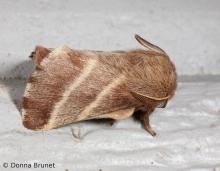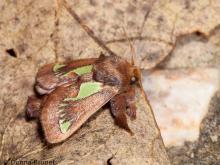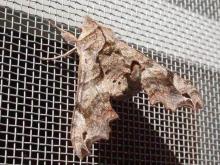Butterflies and Moths
Media

Species Types
Scientific Name
Harrisina americana
Description
Grapeleaf skeletonizer moths have all-black wings that they typically hold flat, away from the body. There is an unbroken collar of red or orange behind the black head.
Media

Species Types
Scientific Name
About 35 species in North America north of Mexico
Description
Tent caterpillar moths and lappet moths are medium-sized, with thick, long scales that make them look furry. The abdomen usually extends past the wings when they are folded back over the body.
Media

Species Types
Scientific Name
About 1,400 species in North America north of Mexico
Description
At rest, tortricid moths often have a distinctive shape, resembling an arrowhead or a bell, with the forewing tips either squared-off or flared outward.
Media

Species Types
Scientific Name
Euclea delphinii
Description
The spiny oak-slug moth is named for its caterpillar, which is armed with gaudy, stiff, stinging spines. If you touch them, the sting can feel something like a bee sting.
Media

Species Types
Scientific Name
Pediasia trisecta
Description
Sod webworms are very common small moths that develop as caterpillars among the roots and leaves of grasses. They are attracted to lights at night.
Media

Species Types
Scientific Name
Deidamia inscriptum
Description
The lettered sphinx is the earliest of our sphinx moths to emerge in springtime and may be seen starting in March and April. This single-brooded resident uses wild grapes, Virginia creeper, and peppervine as its caterpillar food plants.
Media

Species Types
Scientific Name
Costaconvexa centrostrigaria (formerly Orthonama centrostrigaria)
Description
The bent-line carpet and several similar geometrid moths are called carpet moths for their intricate wing patterns, reminiscent of the traditional carpets of Asia and the Middle East.
Media

Species Types
Scientific Name
Patalene olyzonaria
Description
The juniper-twig geometer is one of many geometrid moths that look like a dried-up leaf. Look for them around porch lights April through November. Larvae eat junipers, including eastern red cedar.
Media

Species Types
Scientific Name
Psychomorpha epimenis
Description
The grapevine epimenis flies during daytime and would seem too colorful to be a moth, but a moth it is. They fly in springtime and love to visit wild plum blossoms.
Media

Species Types
Scientific Name
Megalographa biloba (formerly Autographa biloba)
Description
The bilobed looper moth has a conspicuous B-shaped silvery spot on each forewing. Caterpillars of this noctuid moth eat a wide range of plants, and this species is widespread.
See Also


Media

Species Types
Scientific Name
About 1,500 species in North America north of Mexico
Description
Adult caddisflies are mothlike. Their larvae are aquatic and build portable, protective cases out of local materials, including grains of sand, bits of leaves and twigs, and other debris.
Media

Species Types
Scientific Name
Corydalus cornutus
Description
Adult eastern dobsonflies are huge and mothlike, with large wings and a weak, fluttery flight. The fiercely predaceous aquatic larvae, called hellgrammites, are well-known to anglers, who often use them as bait.
About Butterflies and Moths in Missouri
Butterflies, skippers, and moths belong to an insect order called the Lepidoptera — the "scale-winged" insects. These living jewels have tiny, overlapping scales that cover their wings like shingles. The scales, whether muted or colorful, seem dusty if they rub off on your fingers. Many butterflies and moths are associated with particular types of food plants, which their caterpillars must eat in order to survive.





















